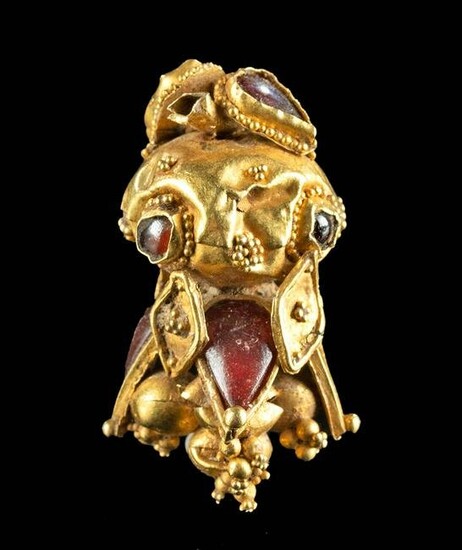Eastern Roman Gold w/ Garnet & Glass Earring
Near East / Western Asia, Parthian or Eastern Roman, ca. 2nd to 3rd century CE. A gorgeous earring comprised of a spherical upper body ornamented with a quintet of spherical bulbs on the bottom. A pair of crimson-hued, drop-form insets - one a garnet and the other glass - flank the slightly compressed suspension tube along the upper body, while 3 petite garnets embellish the spherical midsection, and 4 drop-form glass inlays are shown radiating from the lower body. Clusters of gold granules are applied across the entire composition to create an opulent presentation that would be an impressive display of wealth and status in the ancient world. Size (earring): 0.75" W x 1.33" H (1.9 cm x 3.4 cm); (largest garnet): 0.13" W x 0.24" H (0.3 cm x 0.6 cm); gold quality: 86.4% (equivalent to 20K+); weight: 7.3 grams
Garnets get their name for the Latin word "granatus," meaning "seed-like" - a likely allusion to the similarities in appearance of small red garnets and pomegranate seeds. In antiquity, garnets were popular gemstones, considered just as beautiful as rubies. The very earliest descriptions of garnet date to Roman times; Pliny the Elder (23/24 to 79 CE) referred to the dark-red variety as carbunculus alabandicus, the fire-stone from the city of Alabanda (modern Turkey), an important market place for gemstones found in Asia during Pliny's time.
Provenance: East Coast collection, New York Gallery, New York City, New York, USA, acquired before 2010
All items legal to buy/sell under U.S. Statute covering cultural patrimony Code 2600, CHAPTER 14, and are guaranteed to be as described or your money back.
A Certificate of Authenticity will accompany all winning bids.
PLEASE NOTE: Due to recent increases of shipments being seized by Australian & German customs (even for items with pre-UNESCO provenance), we will no longer ship most antiquities and ancient Chinese art to Australia & Germany. For categories of items that are acceptable to ship to Australia or Germany, please contact us directly or work with your local customs brokerage firm.
Display stands not described as included/custom in the item description are for photography purposes only and will not be included with the item upon shipping.
#142744
Condition Report: Losses to one stone around upper body and one stone around lower body. Indentations to suspension tube, upper body, and spheres on lower body, with losses to some gold granules, minor abrasions to surfaces commensurate with age, and petite fissures to some surfaces. Stone with jagged edges on upper body and all 3 stones on midsection are garnets, and remaining inlays are red-colored glass. Nice patina across surfaces.
View it on
Estimate
Time, Location
Auction House
Near East / Western Asia, Parthian or Eastern Roman, ca. 2nd to 3rd century CE. A gorgeous earring comprised of a spherical upper body ornamented with a quintet of spherical bulbs on the bottom. A pair of crimson-hued, drop-form insets - one a garnet and the other glass - flank the slightly compressed suspension tube along the upper body, while 3 petite garnets embellish the spherical midsection, and 4 drop-form glass inlays are shown radiating from the lower body. Clusters of gold granules are applied across the entire composition to create an opulent presentation that would be an impressive display of wealth and status in the ancient world. Size (earring): 0.75" W x 1.33" H (1.9 cm x 3.4 cm); (largest garnet): 0.13" W x 0.24" H (0.3 cm x 0.6 cm); gold quality: 86.4% (equivalent to 20K+); weight: 7.3 grams
Garnets get their name for the Latin word "granatus," meaning "seed-like" - a likely allusion to the similarities in appearance of small red garnets and pomegranate seeds. In antiquity, garnets were popular gemstones, considered just as beautiful as rubies. The very earliest descriptions of garnet date to Roman times; Pliny the Elder (23/24 to 79 CE) referred to the dark-red variety as carbunculus alabandicus, the fire-stone from the city of Alabanda (modern Turkey), an important market place for gemstones found in Asia during Pliny's time.
Provenance: East Coast collection, New York Gallery, New York City, New York, USA, acquired before 2010
All items legal to buy/sell under U.S. Statute covering cultural patrimony Code 2600, CHAPTER 14, and are guaranteed to be as described or your money back.
A Certificate of Authenticity will accompany all winning bids.
PLEASE NOTE: Due to recent increases of shipments being seized by Australian & German customs (even for items with pre-UNESCO provenance), we will no longer ship most antiquities and ancient Chinese art to Australia & Germany. For categories of items that are acceptable to ship to Australia or Germany, please contact us directly or work with your local customs brokerage firm.
Display stands not described as included/custom in the item description are for photography purposes only and will not be included with the item upon shipping.
#142744
Condition Report: Losses to one stone around upper body and one stone around lower body. Indentations to suspension tube, upper body, and spheres on lower body, with losses to some gold granules, minor abrasions to surfaces commensurate with age, and petite fissures to some surfaces. Stone with jagged edges on upper body and all 3 stones on midsection are garnets, and remaining inlays are red-colored glass. Nice patina across surfaces.



